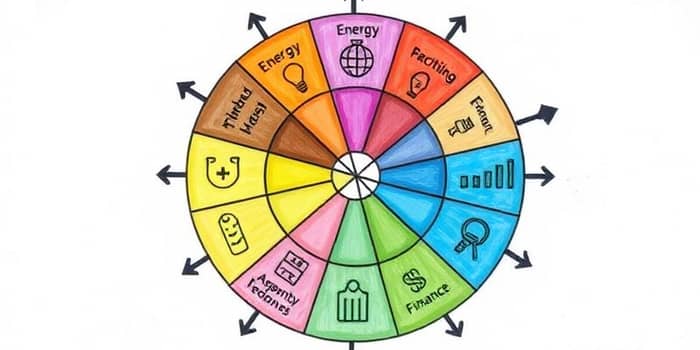
In today’s ever-changing market landscape, investors who can anticipate and act on sector shifts gain a distinct advantage. By understanding how different industries perform during various economic stages, you can strategically position your portfolio to seize growth and manage risk.
Sector rotation is an active investment strategy involving the movement of capital between industry groups to capture returns in line with economic cycles. Instead of a passive buy-and-hold approach, this method seeks to overweight sectors expected to outperform and reduce exposure to those likely to lag.
The stock market is divided into 11 primary sectors—ranging from energy and materials to technology and real estate—each behaving differently depending on macroeconomic forces such as interest rates, consumer spending, and industrial production.
The core principle behind sector rotation is that predictable, cyclic performance patterns emerge as economies move through recession, expansion, peak, and contraction. Investors track leading and coincident indicators—like unemployment rates, manufacturing data, and consumer confidence—to forecast upcoming shifts.
At the bottom of a recession, defensive and growth-oriented segments such as consumer staples, healthcare, and utilities tend to hold value. As recovery gains momentum, cyclical groups such as industrials and materials rally strongly. Approaching a market peak, financials and communication services often shine before a downturn, when capital typically flows back into defensive havens.
This framework offers a structured guide, though real-world performance can vary based on geopolitical events, monetary policy shifts, and unforeseen market shocks.
Consider the 2008–2009 financial crisis. As markets collapsed, investors flocked to utilities and consumer staples. By late 2009, industrial and materials stocks had rebounded sharply, signaling the start of a broader expansion. Sector rotation strategies that reduced cyclicals in early 2008 and reentered them by mid-2009 saw substantial outperformance versus static benchmarks.
In contrast, the 2020 pandemic downturn saw technology and healthcare surge even during contraction, reflecting unique circumstances such as remote work trends and medical innovation. This highlights the importance of blending cycle analysis with qualitative insights and ongoing monitoring and periodic portfolio rebalancing.
Implementing sector rotation requires a disciplined process and access to reliable data. Consider these strategic elements:
Academic research dating back to the mid-19th century confirms the regularity of business cycles, but real-time forecasting remains an art as much as a science. Studies by central banks and academic institutions show that using leading indicators—such as yield curve spreads, manufacturing orders, and consumer sentiment—can improve rotation timing, though no approach guarantees success.
Investors who blend quantitative signals with qualitative insights—monitoring policy announcements, corporate earnings trends, and global risk events—can enhance decision-making and mitigate surprises.
Transform theory into practice with a structured process:
By following a consistent routine and keeping a detailed trading journal, you cultivate discipline, patience, and informed decision-making, all critical for long-term success.
Sector rotation is more than just a tactical maneuver; it reflects a proactive mindset that anticipates change rather than reacts. With disciplined research, strategic timing discipline, and robust risk management, investors can harness the natural ebb and flow of market cycles.
Whether you manage your own portfolio or oversee client assets, integrating sector rotation can sharpen your competitive edge. By continuously scanning the economic horizon and adjusting exposures, you position yourself to capture emerging opportunities and navigate challenges with confidence.
Embrace the rhythms of the market, refine your process over time, and let sector rotation be the engine that drives your capital toward growth—no matter where the cycle turns next.
References













